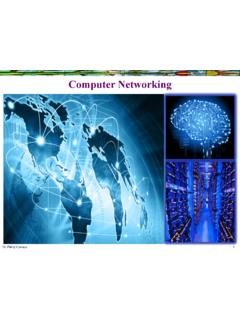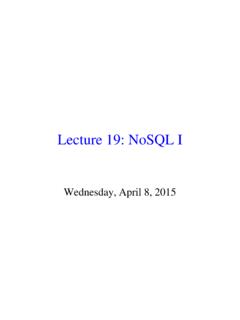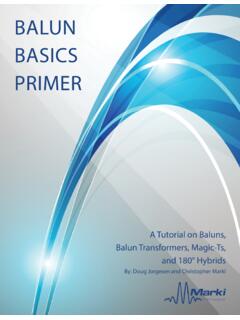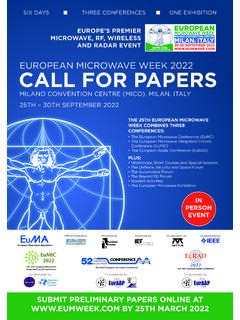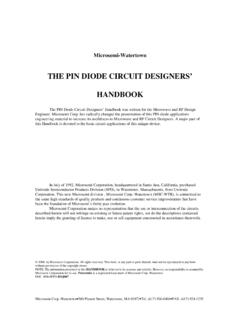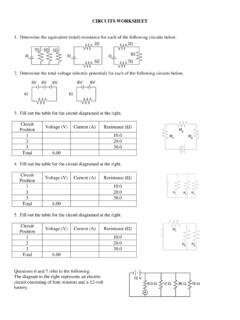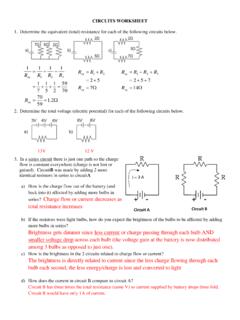Transcription of Cramming More Components onto Integrated Circuits
1 Cramming more Components ontoIntegrated CircuitsGORDON E. MOORE,LIFE FELLOW, IEEEWith unit cost falling as the number of Components per circuitrises, by 1975 economics may dictate squeezing as many as 65 000components on a single silicon future of Integrated electronics is the future ofelectronics itself. The advantages of integration will bringabout a proliferation of electronics, pushing this scienceinto many new Circuits will lead to such wonders as homecomputers or at least terminals connected to a centralcomputer automatic controls for automobiles, and per-sonal portable communications equipment. The electronicwristwatch needs only a display to be feasible the biggest potential lies in the production of largesystems. In telephone communications, Integrated circuitsin digital filters will separate channels on multiplex equip-ment.
2 Integrated Circuits will also switch telephone circuitsand perform data will be more powerful, and will be organizedin completely different ways. For example, memories builtof Integrated electronics may be distributed throughoutthe machine instead of being concentrated in a centralunit. In addition, the improved reliability made possibleby Integrated Circuits will allow the construction of largerprocessing units. Machines similar to those in existencetoday will be built at lower costs and with faster PRESENT ANDFUTUREBy Integrated electronics, I mean all the various tech-nologies which are referred to as microelectronics todayas well as any additional ones that result in electronicsfunctions supplied to the user as irreducible units. Thesetechnologies were first investigated in the late 1950 s.
3 Theobject was to miniaturize electronics equipment to includeincreasingly complex electronic functions in limited spacewith minimum weight. Several approaches evolved, includ-ing microassembly techniques for individual Components ,thin-film structures, and semiconductor Integrated from Gordon E. Moore, Cramming more Components ontoIntegrated Circuits , Electronics,pp. 114 117, April 19, Item Identifier S 0018-9219(98) approach evolved rapidly and converged so thateach borrowed techniques from another. Many researchersbelieve the way of the future to be a combination of thevarious advocates of semiconductor Integrated circuitry arealready using the improved characteristics of thin-filmresistors by applying such films directly to an active semi-conductor substrate. Those advocating a technology basedupon films are developing sophisticated techniques for theattachment of active semiconductor devices to the passivefilm approaches have worked well and are being usedin equipment THEESTABLISHMENTI ntegrated electronics is established today.
4 Its techniquesare almost mandatory for new military systems, since thereliability, size, and weight required by some of them isachievable only with integration. Such programs as Apollo,for manned moon flight, have demonstrated the reliabilityof Integrated electronics by showing that complete circuitfunctions are as free from failure as the best companies in the commercial computer field havemachines in design or in early production employing inte-grated electronics. These machines cost less and performbetter than those which use conventional of various sorts, especially the rapidly in-creasing numbers employing digital techniques, are startingto use integration because it cuts costs of both manufactureand use of linear Integrated circuitry is still restrictedprimarily to the military.
5 Such Integrated functions are ex-pensive and not available in the variety required to satisfy amajor fraction of linear electronics. But the first applicationsare beginning to appear in commercial electronics, partic-ularly in equipment which needs low-frequency amplifiersof small RELIABILITYCOUNTSIn almost every case, Integrated electronics has demon-strated high reliability. Even at the present level of pro-82 PROCEEDINGS OF THE IEEE, VOL. 86, NO. 1, JANUARY 1998duction low compared to that of discrete Components itoffers reduced systems cost, and in many systems improvedperformance has been electronics will make electronic techniquesmore generally available throughout all of society, perform-ing many functions that presently are done inadequately byother techniques or not done at all.
6 The principal advantageswill be lower costs and greatly simplified design payoffsfrom a ready supply of low-cost functional most applications, semiconductor Integrated circuitswill predominate. Semiconductor devices are the only rea-sonable candidates presently in existence for the activeelements of Integrated Circuits . Passive semiconductor el-ements look attractive too, because of their potential forlow cost and high reliability, but they can be used only ifprecision is not a prime is likely to remain the basic material, althoughothers will be of use in specific applications. For example,gallium arsenide will be important in Integrated microwavefunctions. But silicon will predominate at lower frequenciesbecause of the technology which has already evolvedaround it and its oxide, and because it is an abundant andrelatively inexpensive starting COSTS ANDCURVESR educed cost is one of the big attractions of integratedelectronics, and the cost advantage continues to increaseas the technology evolves toward the production of largerand larger circuit functions on a single semiconductorsubstrate.
7 For simple Circuits , the cost per component isnearly inversely proportional to the number of Components ,the result of the equivalent piece of semiconductor inthe equivalent package containing more Components . Butas Components are added, decreased yields more thancompensate for the increased complexity, tending to raisethe cost per component . Thus there is a minimum costat any given time in the evolution of the technology. Atpresent, it is reached when 50 Components are used percircuit. But the minimum is rising rapidly while the entirecost curve is falling (see graph). If we look ahead fiveyears, a plot of costs suggests that the minimum cost percomponent might be expected in Circuits with about 1000components per circuit (providing such circuit functionscan be produced in moderate quantities).
8 In 1970, themanufacturing cost per component can be expected to beonly a tenth of the present complexity for minimum component costs has in-creased at a rate of roughly a factor of two per year(see graph). Certainly over the short term this rate can beexpected to continue, if not to increase. Over the longerterm, the rate of increase is a bit more uncertain, althoughthere is no reason to believe it will not remain nearlyconstant for at least ten years. That means by 1975, thenumber of Components per Integrated circuit for minimumcost will be 65 believe that such a large circuit can be built on a TWO-MILSQUARESWith the dimensional tolerances already being employedin Integrated Circuits , isolated high-performance transistorscan be built on centers two-thousandths of an inch a two-mil square can also contain several kilohmsof resistance or a few diodes.
9 This allows at least 500components per linear inch or a quarter million per squareinch. Thus, 65 000 Components need occupy only aboutone-fourth a square the silicon wafer currently used, usually an inch ormore in diameter, there is ample room for such a structure ifthe Components can be closely packed with no space wastedfor interconnection patterns. This is realistic, since efforts toachieve a level of complexity above the presently availableintegrated Circuits are already under way using multilayermetallization patterns separated by dielectric films. Such adensity of Components can be achieved by present opticaltechniques and does not require the more exotic techniques,such as electron beam operations, which are being studiedto make even smaller INCREASING THEYIELDT here is no fundamental obstacle to achieving deviceyields of 100%.
10 At present, packaging costs so far exceedthe cost of the semiconductor structure itself that there is noincentive to improve yields, but they can be raised as highas is economically justified. No barrier exists comparableto the thermodynamic equilibrium considerations that oftenlimit yields in chemical reactions; it is not even necessaryto do any fundamental research or to replace presentprocesses. Only the engineering effort is the early days of Integrated circuitry, when yields wereextremely low, there was such incentive. Today ordinaryintegrated Circuits are made with yields comparable withthose obtained for individual semiconductor devices. Thesame pattern will make larger arrays economical, if otherconsiderations make such arrays : Cramming Components onto Integrated CIRCUITS83 Fig.


